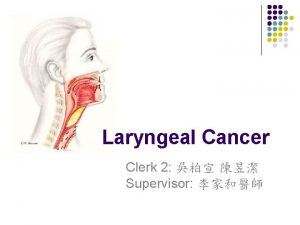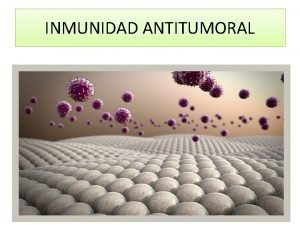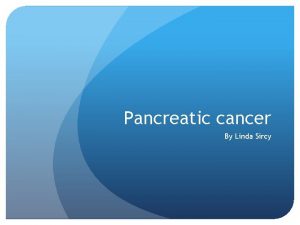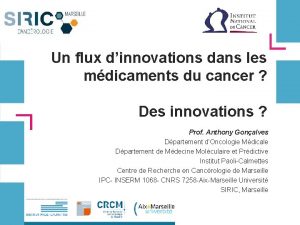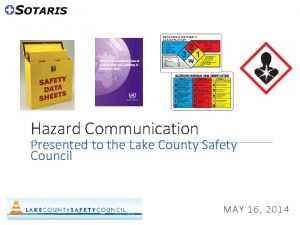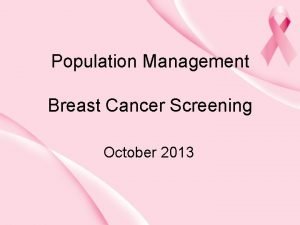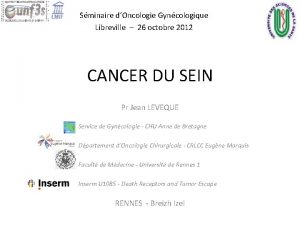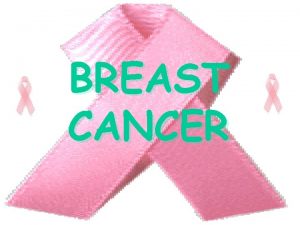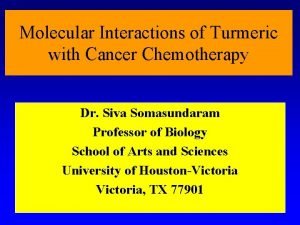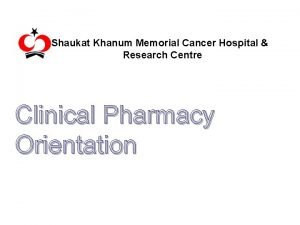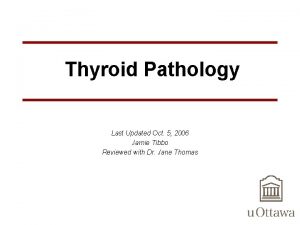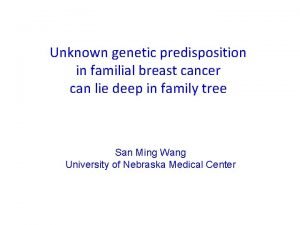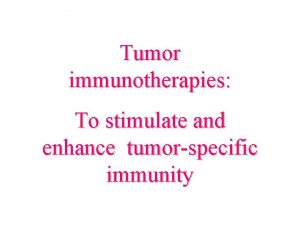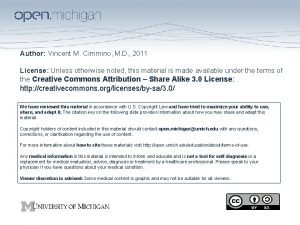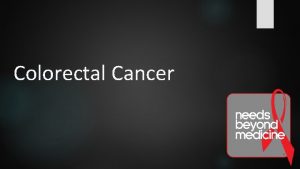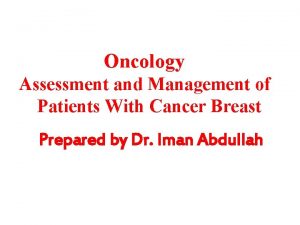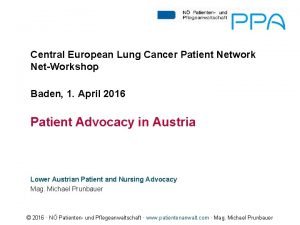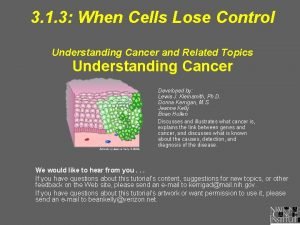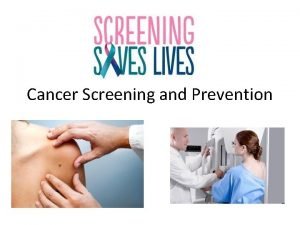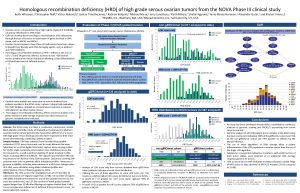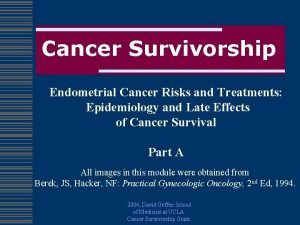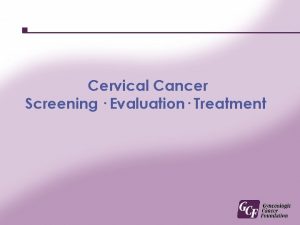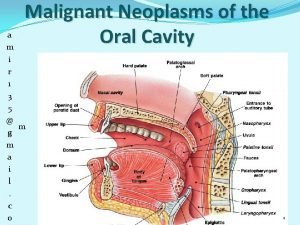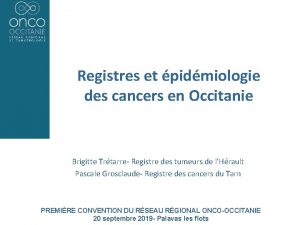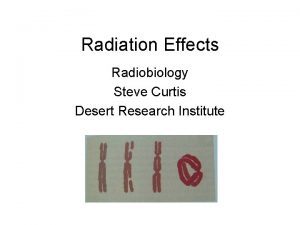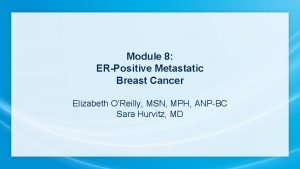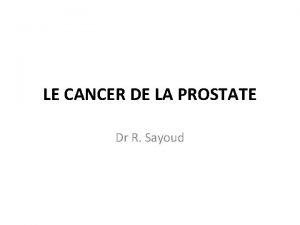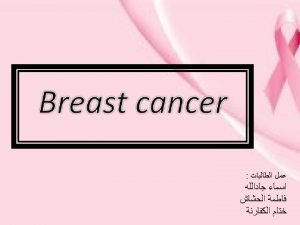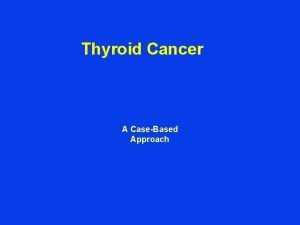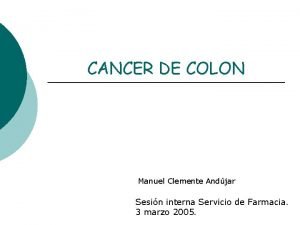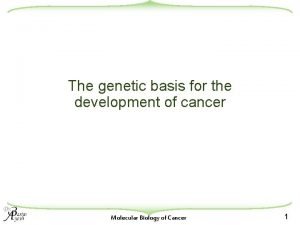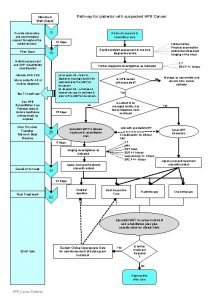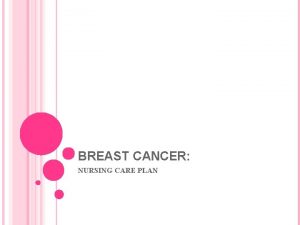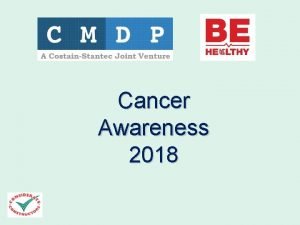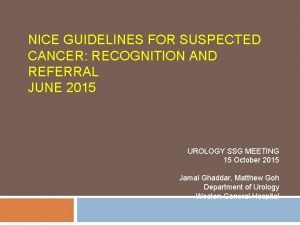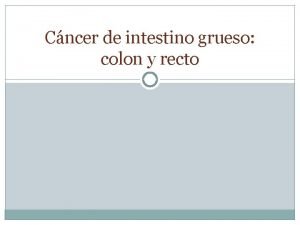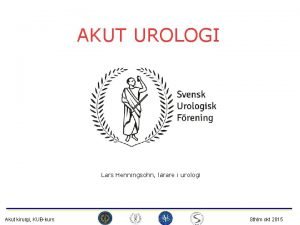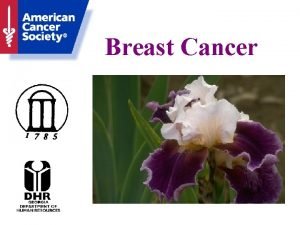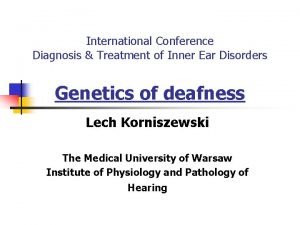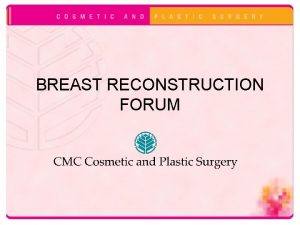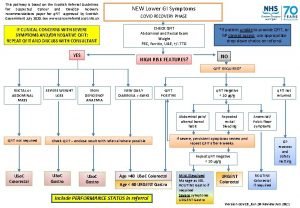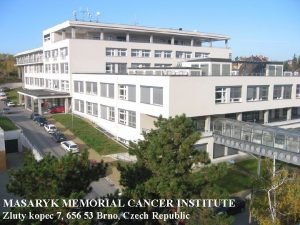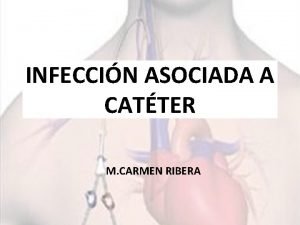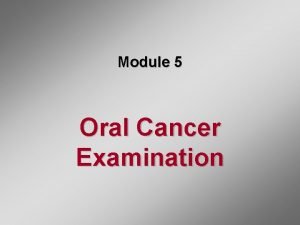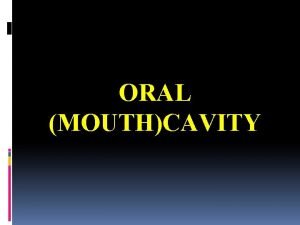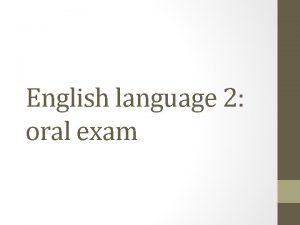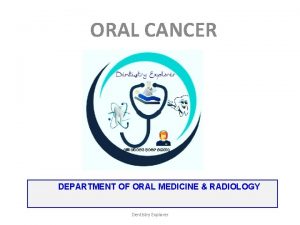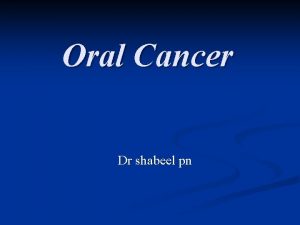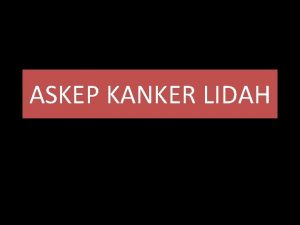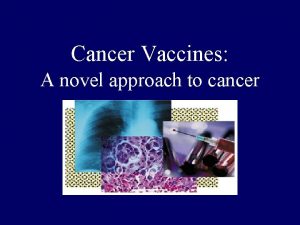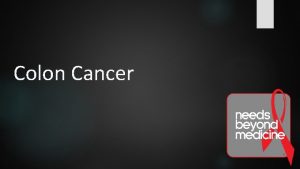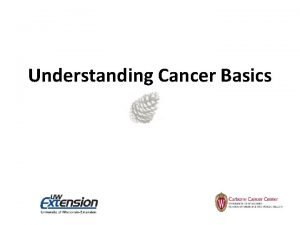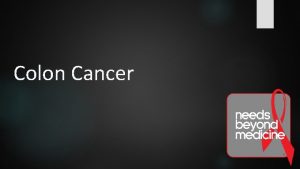ORAL CANCER What is cancer What is oral








































































- Slides: 72

ORAL CANCER

What is cancer What is oral cancer Etiology Tumurogensis Presentation Diagnosis Staging Treating options

POTENTIALLY LIFE THREATENING CONDITION DISFIGUREMENT OF THE FACE FUNCTIONAL INHIBITIONS DIFFICULT TO TREAT

Neoplasia : “is an abnormal mass of tissue the growth of which exceeds and is un coordinated with that of the normal tissues and persists in the same excessive manner even after the cessation of the stimuli which evoked the change”. Willis

Sites Oral cavity extends from the skin-vermillion junction of the lips to the junction of soft and hard palate above and to the line of circumvallate papillae on the tongue below Divided into specific sites – Lip Buccal mucosa Lower alveolus Upper alveolus Retromolar region Floor of the mouth Hard palate Anterior 2/3 rd of tongue

Epidemiology Incidence – oral cancer is one of the 10 leading cancers in the world Histological types �Squamous cell carcinoma – 90. 6% �Verrucous carcinoma – 6% �Others – 5% Sites – � Buccal mucosa - 70% �Alveolus – 20% �Tongue – 7% �Floor of mouth – 5% �Lip – 2%

Age- 90% in persons above 40 years M: F – 7: 3 Stage at presentation 65% - stage 3 75% - had lymph node metastases

Aetiology 1. Tobacco Smoking Chewing Arecanut chewing without tobacco Mixed habit of chewing and smoking 2. Alcohol

Aetiology Others 3. Syphilis 4. Orodental factors 5. Diet & deficiency states 6. Candida infections 7. Viruses 8. Sunlight

Etiology Tobacco Alcohol Malnutrition Trauma Immune deficiencies Candidiasis Viruses Sunlight (actinic radiation)

Clinical evaluation & diagnosis Non-healing ulcers, white or red patches – early symptoms. Ulceroproliferative growth covered with slough, indurated base and everted margins. Pain, bleeding, difficulty in swallowing, speech defect, trismus, lump in the neck – late symptoms.

Intra-oral examination Growth Endophytic Exophytic Ulcer and white patches Number, site, extent, shape, size, margins, floor & base, degree of soft tissue, bone and skin involvement, surrounding induration Degree of mouth opening, restriction of tongue movements Confirmation – incisional biopsy/bone biopsy

How do they look ?



Neck examination Thorough examination for palpable lymphnodes in the neck should be made Check for size, shape, tenderness, consistency, mobility/fixity FNAC of suspected lymphnodes

Spread of tumor Local spread Regional spread Distant spread

Lymphatics of oral cavity Level 1 – submental and submandibular groups Level 2 – upper deep cervical groups along the upper 1/3 rd of I. J. V. Level 3 – mid-deep cervical lymphnodes along the middle 1/3 rd of I. J. V. extending upto superior belly of omohyoid muscle Level 4 – the lower deep cervical lymphnodes along I. J. V. from superior belly of omohyoid Level 5 – Lymphnodes in the postrior triangle of the neck mainly along the spinal acc. n


Imaging PA Mandible, Opg, Occlusal, PNS CT-Scan MRI Radio-nuclide scanning Chest PA


DIAGNOSIS FULL HISTORY PROPER DESCRIPTION OF THE LESION DIAGRAMMATIC ORIENTATION OF THE SPECIMEN RELEVANT RADIOGRAPHS PREVIOUS LABORATORY REPORTS IF ANY BIOPSY OF THE LESION PROVISIONAL DIAGNOSIS Findings recorded to be confirmed with the help of Biopsy

Most intraoral lesions (80 -90%) – Well differentiated squamous cell carcinoma with keratin formation INDURATION OF SURROUNDING TISSUES INDICATES NEOPLASTIC INFILTRATION REGIONAL SPREAD OCCURS ALONG Ø LYMPHATICS Ø NEUROVASCULAR CANAL OF THE MANDIBLE

STAGING EFFECTIVE PROGNOSTIC INDICATOR ACCURATELY DESCRIBES THE TUMOUR WIDELY USED METHOD IS TNM SYSTEM OFFERS TO CATEGORIZE DESCRIPTION OF LESION TO FACILITATE TREATMENT PLANNING TO COMPARE VARIOUS MODALITIES OF TREATMENT PREDICT PROGNOSIS

TNM CLASSIFICATION STAGING GIVEN BY AMERICAN JOINT COm. MITTE ON CANCER(AJCC) INVOLVES THREE PARAMETERS T INDICATES TUMOUR SIZE AND INVASION N INDICATES PRESENCE OR ABSENCE OF LYMPH NODES M INDICATES PRESENCE OR ABSENCE OF METASTASIS

TX PRIMARY TUMOUR CANNOT BE ASSESSED T 0 THERE IS NO EVIDENCE OF PRIMARY TUMOUR Tis CARCINOMA IN SITU T 1 TUMOUR IS 2 CM OR LESS IN GREATEST DIMENSION T 2 TUMOUR IS MORE THAN 2 CM BUT NOT GREATER THAN 4 CM GREATEST DIMENSION IN T 3 TUMOUR IS MORE THAN 4 CM IN GREATEST DIMENSION T 4 TUMOUR INVADES THROUGH CORTICAL BONE, INFERIOR ALVEOLAR NERVE, FLOOR OF MOUTH, OR SKIN OF FACE-i. e OR NOSE T 4 a TUMOUR INVADES ADJACENT STRUCTURES(e. g. , THROUGH CORTICAL BONE, INTO DEEP[EXTRINSIC] MUSCLE OF TONGUE[GENIOGLOSSUS, HYOGLOSSUS, PALATOGLOSSUS, STYLOGLOSSUS], MAXILLARY SINUS, SKIN OF FACE) T 4 b TUMOUR INVADES MASTICATOR SPACE, PTERYGOID PLATES, OR SKULL BASE AND/OR ENCASES THE INTERNAL CAROTID ARTERY CHIN


NX REGIONAL LYMPH NODES CANNOT BE ASSESSED N 0 THERE IS NO REGIONAL NODES METASTASIS N 1 METASTASIS IS IN A SINGLE IPSILATERAL LYMPH NODE, 3 CM LESS IN GREATEST DIMENSION OR N 2 METASTASIS IS IN A SINGLE IPSILATERAL LYMPH NODE, MORE THAN 3 CM BUT NOT MORE THAN 6 CM IN GREATEST DIMENSION; OR METASTASIS IS IN MULTIPLE IPSILATERAL NODES, NONE MORE THAN 6 CM IN GREATEST DIMENSION; OR METASTASIS IS IN BILATERAL OR CONTRALATERAL LYMPH NODES, NONE GREATER THAN 6 CM IN GREATEST DIMENSION N 2 a METASTASIS IS IN A SINGLE IPSILATERAL LYMPH NODE, MORE THAN 3 CM BUT NOT MORE THAN 6 CM IN GREATEST DIMENSION N 2 b METASTASIS IS IN MULTIPLE IPSILATERAL LYMPH MORE THAN 6 CM IN GREATEST DIMENSION NODES, NONE N 2 c METASTASIS IS IN BILATERAL OR CONTRALATERAL LYMPH NODES, NONE MORE THAN 6 CM IN GREATEST DIMENSION N 3 METASTASIS IS IN A LUMPH NODE MORE THAN 6 CM IN GREATEST DIMENSION

MX DISTANT METASTASIS CANNOT BE ASSESSED M 0 THERE IS NO DISTANT METASTASIS M 1 THERE IS DISTANT METASTASIS

STAGE GROUPING STAGE 0 STAGE III STAGE IVA STAGE IVB STAGE IVC Tis T 1 T 2 T 3 T 4 a T 4 b ANY T N 0 N 0 N 1 N 1 N 0 N 1 N 2 N 2 ANY N M 0 N 3 ANY N M 1 M 0 M 0 M 0 M 0

PROGNOSTIC INDICATORS WIDELY USED METHOD OF STAGING IS TNM TO EVALUATE PROGNOSTIC INDICATORS IT WAS EXTENDED TO STNMP “S” REFERS TO SITE OF THE LESION “P” REFERS TO HISTOPATHOLOGY

STNMP Staging (s) Site- Intraoral Ca categorized into different anatomical sites S 1 : lip skin S 2 : Lip mucous membrane S 3 : Tongue S 4 : Cheek S 5 : Palate S 6 : Floor of mouth S 7 : Alveolar process S 8 : Maxillary antrum S 9 : Central Ca of bone

(T) Tumour T 1 : Less than 2 cm T 2 : More than 2 but less than 4 cm T 3 : More than 2 but less than 6 cm and extending beyond the primary region T 4 : More than 6 cm snd extend to involve adjacent structures

Based on presence or absence of residual tumours after treatment: ‘R’ was introduced (R) Residual Tumour Rx : Presence of residual tumour cannot be assessed R 0 : No residual tumour R 1 : Microscopic residual tumour R 2 : Macroscopic residual tumour

(N) Nodal Involvement N 0 : No palpable nodes N 1 : Epithelial node enlargement N 2 : Clinically palpable homolateral regional node not fixed N 3 : Same as N 2 but fixed N 4 : Clinically palpable contra lateral or bilateral node not fixed N 5 : Same as N 4 but fixed (M) Distant Metastasis Mx : Distant mtastasis cannot be assessed M 1 : No distant metastasis M 2 : Distant metastasis

(N) Nodal Involvement N 0 : No palpable nodes N 1 : Epithelial node enlargement N 2 : Clinically palpable homolateral regional node not fixed N 3 : Same as N 2 but fixed N 4 : Clinically palpable contra lateral or bilateral node not fixed N 5 : Same as N 4 but fixed (M) Distant Metastasis Mx : Distant mtastasis cannot be assessed M 1 : No distant metastasis M 2 : Distant metastasis

Pathology P 0 : Hyperkeratotic Lesion showing atypia P 1 : Carcinoma insitu P 2 : Basal cell carcinoma P 3 a : Verrucous Carcinoma P 3 b : Well differentiated SCC P 3 c : Moderately differentiated SCC P 3 d : Poorly differentiated SCC

Differentiation Well differentiated. Moderately differentiated. Poorly differentiated. Squamous cell carcinoma Verrucous Carcinoma

Management Surgery Radiotherapy Chemotherapy Combination of above Palliative treatment

PRINCIPLES OF MANAGEMENT OF ORAL CANCER IS A TEAM APPROACH WHICH INVOLVES GENERAL SURGEON ORAL SURGEON RADIOTHERAPIST CHEMOTHERAPIST

MODALITIES OF TREATMENT AVAILABLE SURGERY IRRADIATION CHEMOTHERAPY ELECTROCOAGULATION CRYOSURGERY LASER VAPORIZATION ANY COMBINATION OF THESE METHODS

CHOICE OF TREATMENT DEPENDS ON THE FOLLOWING FACTORS EXTENT OF THE LESION INVOLVEMENT OF BONE EXTENSION/INFILTRATION INTO THE UNDERLYING TISSUES INCLUDING MUSCLES OF MASTICATION STATUS OF DENTITION HISTOPATHOLOGY AND STAGING PREVIOUS TREATMENT, IF ANY AVAILABILITY OF EXPERTISE AND FACILITIES GENERAL HEALTH OF THE PATIENT

SURGICAL THERAPY GOAL IS COMPLETE REMOVAL OF PRIMARY TUMOUR WITH ADEQUATE MARGIN ALONG WITH REGIONAL LYMPH NODES, DEPENDING ON THEIR INVOLVEMENT IN S. C. C SURGERY IS PRIMARY MODE OF TREATMENT IF BONE IS INVOLVED THEN SURGERY IS THE TREATMENT OF CHOICE

Surgery is carried out depending on variable factors 1. Size and location of tumor 2. Duration 3. Benign vs malignant Histopathological study- i)well differentiated ii)moderately iii) poorly 4. Invasion into bone 5. Diagnosis

Different surgical procedures done are Curettage En-bloc marginal madibular resection A)Intraoral approach B)extraoral Segmental mandibularresection (partial mandibular resection, hemimandibulectomy) 6. Partial /Subtotal maxillectomy 7. Maxillectomy 1. 2. 3. 4. 5.

NECK DISSECTION RECONSTRUCTION MANAGEMENT OF PAIN

IN CASE OF EXTENSIVELY INVOLVED LYMPH NODES NECK DISSECTION IS INDICATED LYMPH NODES IN THE NECK ARE CLASSIFIED AS LEVELS I TO VII LEVEL IA SUBMENTAL GROUP LEVEL IB SUBMANDIBULAR GROUP LEVEL II UPPER JUGULAR GROUP LEVEL III MID-JUGULAR GROUP LEVEL IV LOWER JUGULAR GROUP LEVEL V POSTERIOR TRIANGLE GROUP LEVEL VI CENTRAL COMPARTMENT GROUP LEVEL VII SUPERIOR MEDIASTINAL GROUP

INCISIONS

RND










MRND TYPE I SPINAL ACESSORY NERVE PRESERVED

MRND TYPE II Spinal acessory nerve and IJV preserved

MRND TYPE III All 3 structures preserved

Supraomohyoid neck dissection

RADIOTHERAPY DESTROYS CELLS BY IONIZATION AIM IS TO GIVE MAXIMUM DOSE THAT NORMAL TISSUES CAN TOLERATE SO THAT CHANCES OF KILLING MALIGNANT CELLS ARE MORE TWO PRINCIPAL FORMS OF RADIOTHERAPY �EXTERNAL BEAM MEGAVOLTAGE THERAPY �INTERSTITIAL TECHNIQUES

Tele-radiation – external beam of X-rays/Gamma rays (cobalt 60, caesium 137) Brachytherapy – internally implanted sources of gamma rays (irridium 191, iodine 125) Daily dose of 2 grays (1 gray=100 rads) , 5 days a week for 6 weeks Fractionization – allows repair of cellular injury, repopulation by surviving viable cells, redistribution within the division cycle and re-oxygenation of tumor

Post-operative radiation therapy Positive cut margins (frozen section) Locally advanced lesions (T 3, T 4) High grade anaplastic lesions Peri-neural invasion Multiple lymphnode metastases Extracapsular spread

CHEMOTHERAPY USED AS AN ADVUVANT TO SURGERY OR RADIOTHERAPY OR AS A SINGLE AGENT ACTIVE CHEMOTHERAPEUTIC AGENTS CISPLATINUM BLEOMYCIN 5 -FLUOROURACIL METHOTREXATE

Chemotherapeutic agents Cis-platin 5 -fluorouracil Methotrexate Bleomycin -Interferon

Hazards of therapies. Mucosities. Xerostomia. Trismus. Radiation caries. Fibrosis of the tissues. Osteoradionecrosis. Alopasia. Immune suppression. Anorexia.

Immunotherapy Inhibition of tumour cell growth can occur on attaching a specific monoclonal antibody to a suitable white cell. Antibodies on the tumour specific killer cells thus produced react with target tumour cell antigen , destroying the tumour cell.

Rehabilitation Restoration of appearance and function obturators/feeding plates, partial dentures, implants Jaw physiotherapy Speech therapy Nutritional support Counseling

PREVENTION ABUSE OF TOBACCO IN ALL FORMS TO BE AVOIDED WHENEVER AN ULCER OR WOUND OR SWELLING IN ORAL CAVITY DOES NOT RESPOND IN 2 -3 WEEKS IT SHOULD BE FULLY INVESTIGATED PUBLIC MOTIVATION AVOID PAN CHEWING MASS SCREENING OF POPULATION

Prognosis Disease free life ? 5 year survival rate. Eventual recurrence and death !!!
 Hpv oral cancer
Hpv oral cancer Anatomy of throat
Anatomy of throat Inmunoedicion del cancer
Inmunoedicion del cancer Stage 2b pancreatic cancer
Stage 2b pancreatic cancer Risque cancer du sein
Risque cancer du sein National breast and cervical cancer early detection program
National breast and cervical cancer early detection program May cause cancer pictogram
May cause cancer pictogram Breast cancer risk
Breast cancer risk Missouri cancer registry
Missouri cancer registry Acr3 probabilité cancer forum
Acr3 probabilité cancer forum Cancer boca
Cancer boca Cerebral salt wasting
Cerebral salt wasting Bnox androrush cancer
Bnox androrush cancer Breast cancer biopsy
Breast cancer biopsy Curcumin breast cancer
Curcumin breast cancer Shaukat khanum pharmacy
Shaukat khanum pharmacy Dr jamie tibbo
Dr jamie tibbo Limon congelado para el cancer
Limon congelado para el cancer Prostate cancer staging
Prostate cancer staging Breast cancer genes
Breast cancer genes Nature reviews cancer
Nature reviews cancer Treatment of inflammatory breast cancer
Treatment of inflammatory breast cancer Colon cancer pathway
Colon cancer pathway Nursing care plan for breast cancer ppt
Nursing care plan for breast cancer ppt Central european lung cancer patient network
Central european lung cancer patient network Randy testicular cancer
Randy testicular cancer Dt56a side effects
Dt56a side effects Anatomy and physiology of psoriasis
Anatomy and physiology of psoriasis Cancer prefix
Cancer prefix Abcd skin cancer
Abcd skin cancer Hrd score ovarian cancer
Hrd score ovarian cancer Endometrial cancer
Endometrial cancer Single cancer pathway
Single cancer pathway What is cancer
What is cancer Luminal a breast cancer
Luminal a breast cancer Lcif childhood cancer
Lcif childhood cancer Swag cancer alliance
Swag cancer alliance Cancer
Cancer Hospital max peralta extensiones
Hospital max peralta extensiones Lic cancer cover plan 905
Lic cancer cover plan 905 Ralph steinman pancreatic cancer
Ralph steinman pancreatic cancer Floor of mouth cancer
Floor of mouth cancer Cancer de vessie
Cancer de vessie Steve curtis cancer
Steve curtis cancer Cdk breast cancer
Cdk breast cancer Espérance de vie après récidive cancer prostate
Espérance de vie après récidive cancer prostate Chapter 24 the immune and lymphatic systems and cancer
Chapter 24 the immune and lymphatic systems and cancer Cancer biomedicine
Cancer biomedicine Breast cancer development stages
Breast cancer development stages Northern cancer alliance
Northern cancer alliance Risk factors of head and neck cancer
Risk factors of head and neck cancer Thyroid cancer: a case-based approach
Thyroid cancer: a case-based approach Cancer de colon
Cancer de colon Rankl antibody
Rankl antibody The genetic basis of cancer
The genetic basis of cancer Hpb cancer
Hpb cancer Vax 2 stop cancer
Vax 2 stop cancer Nursing assessment of breast cancer
Nursing assessment of breast cancer Tobacco causes _______ of cancer deaths around the world. *
Tobacco causes _______ of cancer deaths around the world. * Linha divisoria do mundo norte e sul
Linha divisoria do mundo norte e sul Suspected cancer recognition and referral
Suspected cancer recognition and referral Clasificacion de dukes cancer colon
Clasificacion de dukes cancer colon Uretäroskopisk stenextraktion
Uretäroskopisk stenextraktion Dephosphorylation
Dephosphorylation Breast cancer anatomy and early warning signs
Breast cancer anatomy and early warning signs Kolposkopi px
Kolposkopi px Ovarian cancer brca
Ovarian cancer brca Pes statement for cancer
Pes statement for cancer Breast cancer reconstruction forum
Breast cancer reconstruction forum Tropic of cancer 23 1/2
Tropic of cancer 23 1/2 Scottish cancer referral guidelines
Scottish cancer referral guidelines Masaryk memorial cancer institute
Masaryk memorial cancer institute Lock therapy vancomicina
Lock therapy vancomicina

